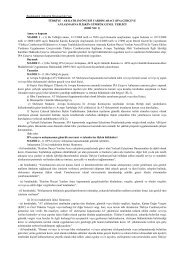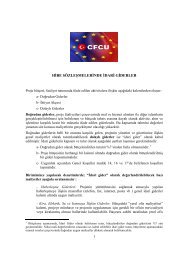Project Cycle Management Training Handbook - CFCU
Project Cycle Management Training Handbook - CFCU
Project Cycle Management Training Handbook - CFCU
Create successful ePaper yourself
Turn your PDF publications into a flip-book with our unique Google optimized e-Paper software.
28<br />
<strong>Project</strong> <strong>Cycle</strong> <strong>Management</strong> <strong>Training</strong> <strong>Handbook</strong><br />
• Policy support – the extent to which the partner government have<br />
demonstrated support for the continuation of project services<br />
beyond the period of donor support.<br />
• Appropriate technology – whether the technologies applied by the<br />
project can or should continue to operate in the longer run (eg.<br />
availability of spare parts; sufficiency of safety regulations;<br />
appropriateness to local capabilities for operation and<br />
maintenance).<br />
• Institutional and management capacity – the ability and<br />
willingness of the implementing agencies to continue to deliver<br />
project services beyond the period of donor support.<br />
• Economic and financial viability – whether the incremental<br />
benefits of the project outweigh its costs, and the project represents<br />
a viable long-term investment. 4<br />
• Socio-cultural and gender issues affecting motivation and<br />
participation – the extent to which the needs of all beneficiary<br />
groups will be addressed by the project and the effect this will have<br />
on the distribution of benefits in the longer term. 5<br />
• Environmental protection – the extent to which the project will<br />
preserve or damage the ecological environment and therefore<br />
support or undermine achievement of longer term benefits. 6<br />
These factors are assessed in terms of their probability and<br />
significance in the same way as external factors (using the algorithm),<br />
either being discarded as unimportant, included as assumptions in the<br />
4<br />
The Financial and Economic Analysis Manual (EC 1997) provides a comprehensive methodology to be used at<br />
the different phases of the project cycle.<br />
5<br />
The most common tool for integrating environment into the different phases of the project cycle is the<br />
Environment Impact Assessment (EIA). In DG 1B, the EIA procedures are described in the EIA Guidance Note.<br />
In DG VIII, the procedures are outlined in the Environment Manual. Currently, these procedures are being<br />
revised and harmonised to be integrated in a new Environment Integration Manual.<br />
6<br />
Further materials can be requested from the Gender & Development Desks in DG 1B (Gender In Development<br />
Manual, 1992; Gender Impact Assessment – GIA- Procedures and Guidelines) and DGVIII (Gender and <strong>Project</strong><br />
<strong>Cycle</strong> <strong>Management</strong>, Notes on Gender & Development, Standard Format for <strong>Project</strong> Identification).<br />
Add your own notes here…





